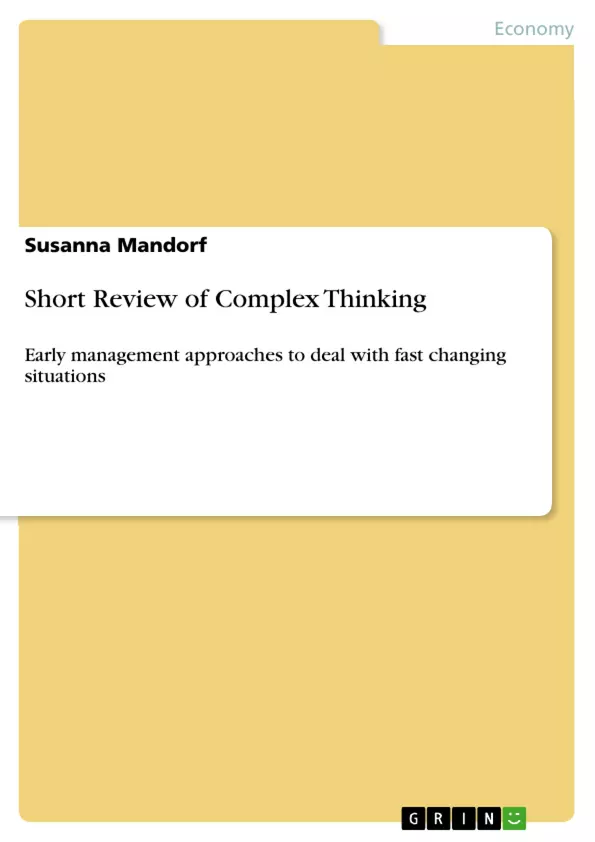
Short Review of Complex Thinking
Fachbuch, 2009
51 Seiten
Leseprobe
Inhaltsverzeichnis (Table of Contents)
- 1. Introduction
- 2. The Model of Viable Systems (Self-Regulation)
- 2.1. The viable systems
- 2.2. The Cognitive School of strategic management
- 3. View of Systemic Perspective and Cybernetics
- 3.1. Systems Theory
- 3.2. Cybernetics
- 4. Synergy Effects by Ansoff
- 4.1. Synergy effects
- 4.2. Planning School of Strategic Management
- 5. Interaction with the Environment
- 5.1. Business Environment
- 5.2. Environment School
- 6. Phenomenon of Learning (Adaptation)
- 6.1. Learning as a basic quality
- 6.2. The Learning School of Strategic Management
- 7. Summary and Expectations
Zielsetzung und Themenschwerpunkte (Objectives and Key Themes)
This report aims to present early management approaches that addressed the increasing complexity within companies and their environments. It examines how economists and businesspeople attempted to manage this complexity, highlighting the evolution of complex thinking in business management.
- The Model of Viable Systems and its application to organizational structures.
- The role of systems theory and cybernetics in understanding and managing complex systems.
- Ansoff's concept of synergy effects and their implications for interdependencies within organizations.
- The interaction between companies and their environments, focusing on adaptation and the contingency approach.
- The phenomenon of learning and adaptation as a key aspect of strategic management in complex systems.
Zusammenfassung der Kapitel (Chapter Summaries)
1. Introduction: This introductory chapter sets the stage by outlining the report's objective: to explore early management approaches dealing with the rising complexity within companies and their external environments. It highlights the historical challenge of managing this complexity, mentioning attempts at simplification for easier analysis versus the challenges of maintaining complexity for a more holistic understanding. The chapter emphasizes the need to understand these early approaches to trace the development of complex thinking in business management and foreshadows the subsequent examination of specific models and theories.
2. The Model of Viable Systems (Self-Regulation): This chapter delves into Beer's Model of Viable Systems, using the analogy of the human body to explain the hierarchical structure of companies. It likens top management to the brain and spinal cord, highlighting the importance of self-regulation through backward control for maintaining stability in the face of external disturbances. The chapter connects this model to the concept of adaptation and sets the ground for the following discussions of systems theory and cybernetics.
3. View of Systemic Perspective and Cybernetics: This chapter explores the systemic perspective and cybernetic elements crucial for understanding and managing complex systems. It expands on the concepts introduced in the previous chapter, examining how systems theory and cybernetics offer frameworks for analyzing and controlling intricate organizational structures and their responses to internal and external stimuli. The chapter likely contrasts this approach with other managerial paradigms that were prevalent at the time.
4. Synergy Effects by Ansoff: This chapter focuses on Ansoff's work on synergy effects, examining the interdependencies within organizations. It classifies synergies as positive, negative, or neutral, illustrating how the interactions between different departments or units can either enhance or hinder overall organizational effectiveness. This analysis lays the groundwork for understanding the internal dynamics of complex systems.
5. Interaction with the Environment: This chapter investigates the crucial interplay between organizations and their external environments. It discusses the blurring of boundaries due to interconnected value chains and processes, making it difficult to objectively define the system's capacity. The chapter likely introduces the contingency approach, emphasizing the continuous adaptation of companies to environmental changes.
6. Phenomenon of Learning (Adaptation): This chapter explores learning and adaptation as fundamental qualities of organizations navigating complex environments. It delves into the concept of the learning organization, examining how continuous learning and adaptation are essential for success in dynamic and unpredictable circumstances. The chapter likely connects this concept to previous discussions of self-regulation and environmental interaction.
Schlüsselwörter (Keywords)
Complex systems, strategic management, systems theory, cybernetics, viable systems model, synergy effects, adaptation, learning organization, contingency approach, organizational complexity, environmental influence.
Frequently Asked Questions: A Comprehensive Language Preview
What is this document about?
This document provides a comprehensive preview of a report exploring early management approaches to address increasing complexity within companies and their environments. It examines how economists and businesspeople attempted to manage this complexity, highlighting the evolution of complex thinking in business management. The preview includes a table of contents, objectives and key themes, chapter summaries, and keywords.
What are the main topics covered in the report?
The report covers several key topics, including the Model of Viable Systems (self-regulation), systems theory and cybernetics, Ansoff's synergy effects, interaction with the environment, and the phenomenon of learning and adaptation in strategic management. It explores how these concepts relate to managing complexity within organizations.
What is the Model of Viable Systems?
The Model of Viable Systems, discussed in Chapter 2, uses the analogy of the human body to explain the hierarchical structure of companies. It emphasizes self-regulation through backward control to maintain stability in the face of external disturbances. It likens top management to the brain and spinal cord.
What is the role of systems theory and cybernetics?
Chapter 3 explores the systemic perspective and cybernetic elements crucial for understanding and managing complex systems. Systems theory and cybernetics provide frameworks for analyzing and controlling intricate organizational structures and their responses to internal and external stimuli.
What are Ansoff's synergy effects?
Chapter 4 focuses on Ansoff's work on synergy effects, analyzing the interdependencies within organizations. It examines how interactions between different departments or units can positively, negatively, or neutrally impact overall organizational effectiveness.
How does the report address the interaction with the environment?
Chapter 5 investigates the interplay between organizations and their external environments. It discusses the challenges of defining system capacity due to interconnected value chains and processes and likely introduces the contingency approach, emphasizing continuous adaptation to environmental changes.
What is the importance of learning and adaptation?
Chapter 6 explores learning and adaptation as fundamental aspects of organizations navigating complex environments. It delves into the concept of the learning organization and its importance for success in dynamic and unpredictable circumstances.
What are the key takeaways from the report preview?
The preview highlights the historical development of complex thinking in business management. It shows how early management theories attempted to grapple with increasing organizational and environmental complexity through models and frameworks emphasizing self-regulation, adaptation, and the interaction between internal and external factors.
What are the key words associated with the report?
Key words include: Complex systems, strategic management, systems theory, cybernetics, viable systems model, synergy effects, adaptation, learning organization, contingency approach, organizational complexity, environmental influence.
Where can I find the full report?
The full report is not included in this preview. Further information on obtaining the complete report would need to be sought from the publishing company.
Details
- Titel
- Short Review of Complex Thinking
- Untertitel
- Early management approaches to deal with fast changing situations
- Veranstaltung
- Business Management: Strategic Management
- Autor
- PhD (ABD), M.Sc. Susanna Mandorf (Autor:in)
- Erscheinungsjahr
- 2009
- Seiten
- 51
- Katalognummer
- V122675
- ISBN (eBook)
- 9783640292523
- ISBN (Buch)
- 9783640292585
- Dateigröße
- 698 KB
- Sprache
- Englisch
- Anmerkungen
- Es handelt sich um ein Fachbuch zum strategischen Management. Die Arbeit faßt bekannte grundlegende Ansätze aus der Literatur zusammen, welche sich mit einer schnell wechselnden Umwelt und sehr komplexen Bedingungen für Unternehmen befassen. Typische Schulen und bekannte Autoren werden behandelt und ein Ausblick auf die nähere zu erwartende Entwicklung gewährt.
- Schlagworte
- strategic management management complexity management approaches self-regulation viable systems Beer Ansoff systemic perspective cybernetics synergies synergy effects systems theory systems planning school business environment leanring organization learning company environmental school Mintzberg learning school St. Gallen Strategy Safari Competitive Strategy leadership Führung Komplexität Komplexitätsmanagement Change management
- Produktsicherheit
- GRIN Publishing GmbH
- Preis (Ebook)
- US$ 19,99
- Preis (Book)
- US$ 28,99
- Arbeit zitieren
- PhD (ABD), M.Sc. Susanna Mandorf (Autor:in), 2009, Short Review of Complex Thinking, München, Page::Imprint:: GRINVerlagOHG, https://www.diplomarbeiten24.de/document/122675
- Autor werden
- Ihre Optionen
- Vertriebskanäle
- Premium Services
- Autorenprofil
- Textarten und Formate
- Services für Verlage, Hochschulen, Unternehmen

- © GRIN Publishing GmbH.
- Alle Inhalte urheberrechtlich geschützt. Kopieren und verbreiten untersagt.
- info@grin.com
- AGB
- Open Publishing
Der GRIN Verlag hat sich seit 1998 auf die Veröffentlichung akademischer eBooks und Bücher spezialisiert. Der GRIN Verlag steht damit als erstes Unternehmen für User Generated Quality Content. Die Verlagsseiten GRIN.com, Hausarbeiten.de und Diplomarbeiten24 bieten für Hochschullehrer, Absolventen und Studenten die ideale Plattform, wissenschaftliche Texte wie Hausarbeiten, Referate, Bachelorarbeiten, Masterarbeiten, Diplomarbeiten, Dissertationen und wissenschaftliche Aufsätze einem breiten Publikum zu präsentieren.
Kostenfreie Veröffentlichung: Hausarbeit, Bachelorarbeit, Diplomarbeit, Dissertation, Masterarbeit, Interpretation oder Referat jetzt veröffentlichen!
- GRIN Verlag GmbH
-
- Nymphenburger Str. 86
- 80636
- Munich, Deutschland
- +49 89-550559-0
- +49 89-550559-10
- info@grin.com
-









